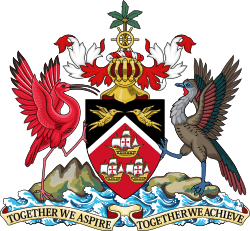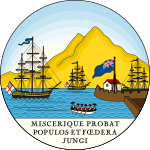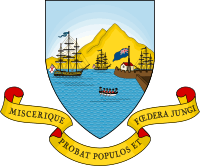Coat of arms of Trinidad and Tobago
| Coat of arms of Trinidad and Tobago | |
|---|---|
 | |
| Details | |
| Armiger | Republic of Trinidad and Tobago |
| Adopted | 1962 |
| Crest | A palm tree Proper surmounted by a ship's wheel Or. |
| Escutcheon | Per chevron sable and gules, a chevronel argent between in chief two hummingbirds volant respectant Or and in base three carracks one and two of the last sailed of the third, the mainsails charged with a cross pattée of the second. |
| Supporters | A scarlet ibis and a cocrico, both proper. |
| Compartment | Waves of the sea, issuing on the dexter a mount of three peaks representing the Trinity Hills, and on the sinister an isle representing Tobago, all proper. |
| Motto | "Together we aspire, together we achieve" |
The coat of arms of Trinidad and Tobago was designed by a committee formed in 1962 to select the symbols that would be representative of the people of Trinidad and Tobago. The committee included noted artist Carlisle Chang (1921–2001) and carnival designer George Bailey (1935–1970).[1][2]
Design
The palm tree crest at the top of the coat of arms was taken from Tobago’s coat of arms before it was joined in political union with Trinidad. The shield comprises the same colours (black, red, and white) as the nation’s flag and carry the same meaning. The gold ships represent the Santa María, La Niña, and La Pinta: the three ships Christopher Columbus used on his journey to the “New World”. The two birds on the shield are hummingbirds. Trinidad is sometimes referred to as the “Land of the Hummingbird” because 18 different species of hummingbird have been recorded on the island. “Land of the Hummingbird” is also believed to have been the Native American name for Trinidad. The two larger birds are the Scarlet Ibis (left) and the Cocrico (right), the national birds of Trinidad and Tobago. Below the Scarlet Ibis are three hills, representing the Trinity Hills in southern Trinidad, which, it is believed, convinced Columbus to name the island after the Holy Trinity. The island rising out of the waters beneath the Cocrico represents Tobago. Below these birds is the nation’s motto, "Together We Aspire, Together We Achieve."
Historical
| Colony of Trinidad and Tobago | ||
| Emblem | Period of use | Notes |
|---|---|---|
 |
1889–1958 | The badge of the crown-colony depicts the harbour of Port of Spain and mount El Tucuche with two Royal Navy frigate flying the white ensign and a boat with crew in the foreground. In base is the motto MISCERIQUE PROBAT POPULOS ET FOEDERA JUNGI, chosen by Sir Ralph Abercromby who captured Trinidad from the Spanish in 1797. The motto is quote from Virgil's Aeneid (Book IV, Line 112): ‘Miscerive probet populos, aut foedera iungi ’(He approved of the mingling of peoples and their being joined together by treaties). |
 |
1958–1962 | Placed on a heraldic shield with the motto on a ribbon, the badge of Trinidad was adopted by Letters patent of the 13 of October 1958 as the coat of arms of the colony. However the arms was not retained after Independence in 1962. |
See also
References
- ↑ "Carlisle Chang (1921–2001)" Archived 2015-07-11 at the Wayback Machine., NALIS.
- ↑ "Coat of Arms", The National Identity Guidelines of the Republic of Trinidad and Tobago (Ministry of National Diversity and Social Integration, Government of the Republic of Trinidad and Tobago), p. 4.